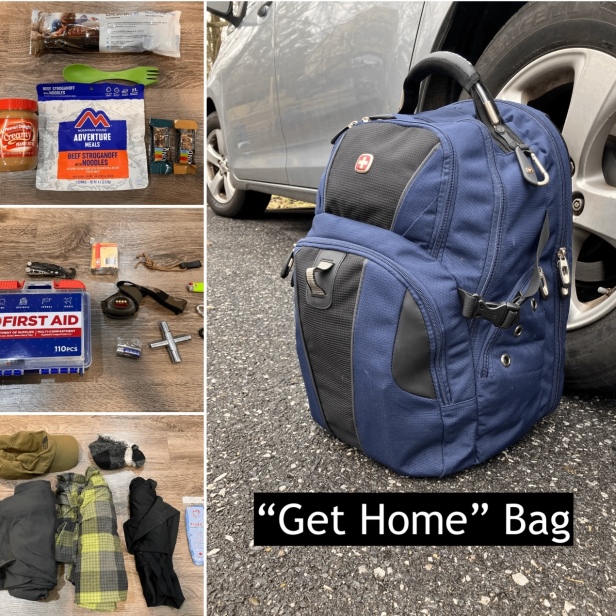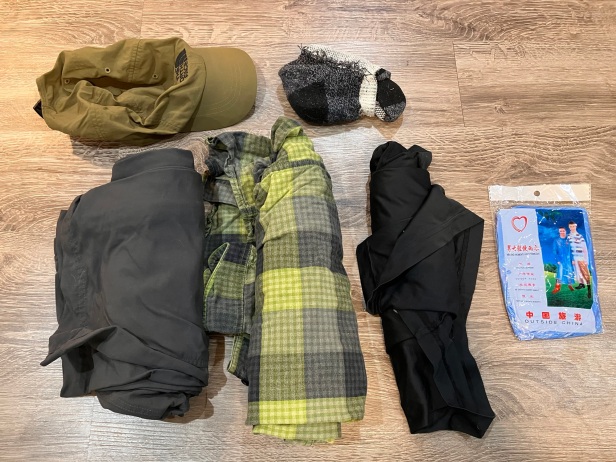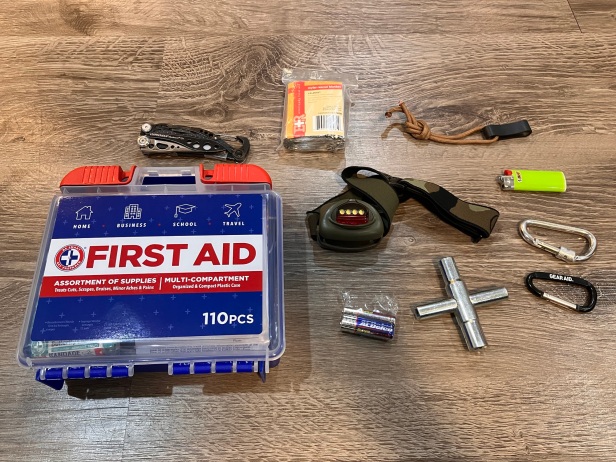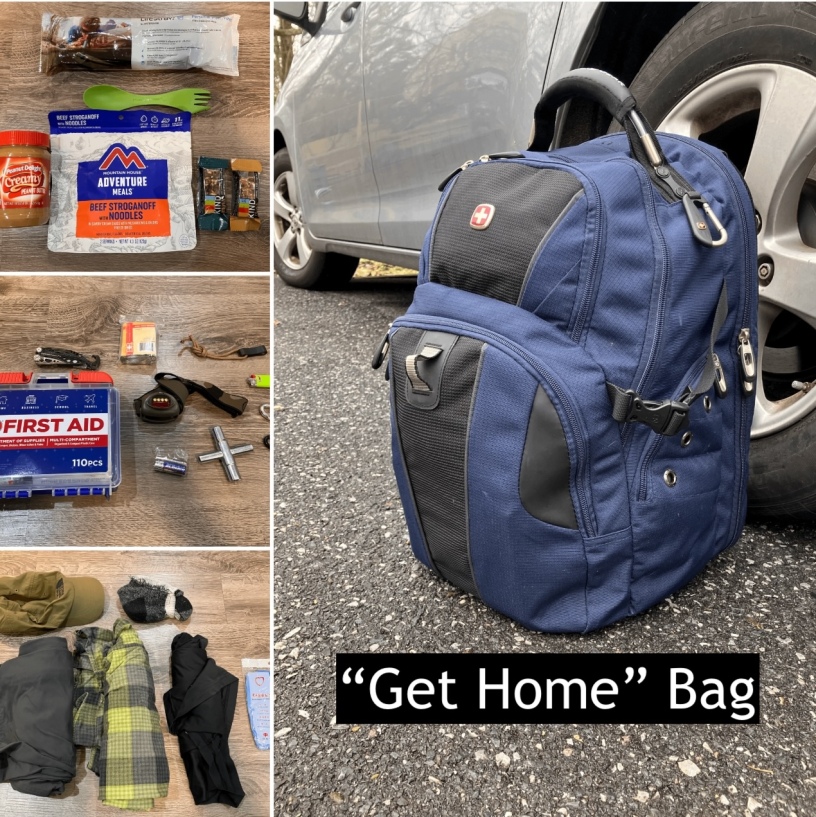Many people on the Internet love to provide their ideas for “bug out” bags – bags full of gear and supplies to carry with you as you escape an emergency or SHTF scenario. I’m not sure many of these people have any idea where they’d go though. I don’t know about you, but unless a natural disaster is forcing me from my home – such as a flood or hurricane – my plan in any emergency scenario is to “bug in” with my family. But what about if that emergency happens while you’re at work? Do you have what you need to get home safely? Do you have a “get home” bag?

The emergencies I’m talking about aren’t that farfetched. I’m not talking about the end of the world here – humans have survived plagues, wars, and more that by today’s standards would be considered apocalyptic. The end of the world just ain’t gonna happen like movies portray it. No, what I’m talking about here are emergencies that are reasonably likely to happen in your lifetime, and that may have you stuck where you work – far from home. Some examples for you to consider:
- After 9/11, many people had trouble getting home because the city was gridlocked. Public transportation and car traffic came to a halt, and people had trouble using their cell phones because of increased traffic.
- A few years ago there were rumors of truckers shutting down the DC beltway in protest. Such a shutdown would prevent many people from getting home for an unknown amount of time.
- Many blizzards have left people stuck at work or in their cars for a prolonged period of time until the storm cleared and they were able to make their way home.
In any of these situations, I assure you the average person does not have what they’d need to be comfortable and prepared for the journey home from work should they find themselves stuck. I work over 30 miles from where I live, and with my experience backpacking I can tell you that if I had to walk home in such an emergency, I’d be miserable without some essentials. While walking home such distances might seem crazy to some, I’m doing everything I can to get home to my family and you should too. As a parent your #1 responsibility in this situation is to get home and make sure your family is safe. So let’s get prepared and see what should go into your “get home” bag.
First and foremost, I recommend you use as much of what you already have to create your get home bag – don’t spend a bunch of money to make your bag. Scrounge around the house and use what you already have and then fill the gaps with new purchases. You may never need it, so don’t go broke building it out.
The Bag Itself
Any backpack in the 30 liter range should do. I personally use a Swiss Gear laptop backpack I received as a Christmas gift over 15 years ago. It’s a big bag and nice quality – but I don’t really fly solo that much so I never found a niche for it. So I made it my get home bag. My bag doesn’t have a waist belt or chest strap, which would be ideal for a long walk, but it’s meant to make do so that’s alright. I only have to walk ~30 miles if I need to get home – some suffering is to be expected.

Find an old bag you have in the 30 liter range and make it your get home bag. If you don’t have such a bag lying around, something cheap like this ZOMAKE Lightweight Packable Backpack will do. Don’t get anything tactical looking. You want to stay low profile on your way home – other people may not be as prepared as you and target you if you look prepared.
Food and Water
Depending on how long it will take you to get home, it’s a good idea to have some food and water available. Walking long distances burns lots of energy – you’ll need to re-up with food. And you will surely get thirsty walking any long distance.
For food, you could pack almost anything in your get home bag – you just need calories. I keep a couple protein bars, a small jar of peanut butter, and a single backpacker meal. I don’t have a stove or pot to make a hot backpacker meal. If it came to it, I’d go with a cold, long soak to make the backpacker meal edible. This trifecta should provide enough calories to get me through my over 30 mile walk. Pack what makes the most sense for you. Don’t forget the utensil!

Since I always have a Nalgene with me, I don’t keep an extra water bottle. Instead, I have a Lifestraw that my mom gave me for Christmas many years ago and a sillcock key in the bag. I’m not going to dive into the ethics of tapping into a private water source, because in my opinion survival trumps any concerns, but for those who aren’t aware a sillcock key is a metal tool that allows you to turn on spigots with keyed access, i.e. that you need such a key to turn them on. Many corporate buildings use these to prevent theft of their water. A sillcock key really opens up water access for you in an emergency. This setup allows me to collect water along the way from almost any source – streams, puddles, ponds, and spigots on almost any type of building.
Clothing and Accessories
Your journey may take a a day or two to achieve depending on your commute and the nature of the emergency. Some extra clothes and accessories may come in handy, and be more comfortable than the work clothes you’d have on.
This is where you should really leverage what you already have. Also, what clothing and accessories you pack should vary by season (or just pack it all and leave it if you don’t want to put too much thought into it).
Warmer months:
- Long sleeve performance shirt (sleeves can be rolled up in summer)
- Convertible pants (can unzip into shorts if needed, such as on a hot summer day)
- Lightweight socks
- Baseball cap
- Underwear
- Rain poncho

Colder months:
- Long johns
- Thick wool socks
- Beanie
- Gloves
- Fleece or insulated jacket

There’s no need to perfect this, just enough to make any potential extended journey home more comfortable.
Shelter
Depending on the emergency and distance from home, you may have to spend at least one night out on the road before you get home. You should be prepared to sleep outdoors if you’re exhausted and you need to recoup some energy on your journey. I don’t suggest you carry a sleeping bag, sleeping pad, or pillow. That’s a lot of extra weight and bulk to pack for a big IF and ideally no more than one night on the road (unless you live really far from work). I take the minimalist approach and just have a cheap tarp with cordage and stakes in my kit. I also have a cheap emergency bivy from Amazon that my mom got me for Christmas (same Christmas as the Lifestraw lol) which provides additional insurance in case it’s cold.

You just need to get a few hours of sleep to recoup some energy, so this minimal system will protect you from the elements while you get some necessary shut eye. If the weather is fine, you may not need it. But if you’ve never tried to sleep exposed to the elements, I can tell you that having a tarp and/or emergency bivy will provide both physical and psychological assurance.
Miscellaneous Survival Gear
You should keep in your bag some key survival gear to help you along your way. The list below should be in your get home bag to round out your kit:
- First aid kit – this is a must! You might get injured or at least get blisters walking for which you may want some bandaids. Do not forget this!!
- Multitool – who knows what you may need to cut or repair with this, but best to have it and not need it, yadda yadda
- Mylar rescue blanket – gives yourself some additional warmth, if needed
- Headlamp – if your journey will go into night / overnight, this will be essential. Don’t forget extra batteries!
- Fire starting implements – a lighter and some items to get a fire going, such as the GEAR AID 550 Firestrand paracord and a ranger band (very flammable and holds a flame)
- Carabiners – in case you have to clip anything extra onto your pack along the way. Use any miscellaneous crappy ones you have lying around, if you do.
- Self-defense protection – whatever this means to you, and related to your working and local law requirements (i.e. if you work in a non-permissive environment or live in a locality with restrictions you will be much more limited). The multitool’s knife may work for this also.

Extra Space!
Leave a little extra space in your bag for anything you might need to take home from work. In my case, I left room for my work laptop so I can work from home if necessary after my journey. Such an emergency may not equate to a get out of work free card, so make sure you have what you need to work if your job is such that you could telework / work from an alternate location.
Other Preps
In addition to my “get home” bag, there are some items I always keep in my car to be prepared that may come in handy in any situation that has you walking home a relatively long distance. These don’t need to go into your get home bag, but you can bring them along as necessary.
First, I keep a road atlas in each car. You never know when you might be out of signal or have a broken phone and need to find your way. Well, having an atlas may help you walk home too. If you don’t feel safe walking along your normal commuting route, e.g. a highway, you can use the road atlas to find more walkable roads.
Second, I keep cash in each car. Not a lot, just enough for what I might need to get me out of a tight spot. $60 should be plenty for gas, tipping a tow truck driver, buying food and water in a pinch, or whatever minor cash needs may come up in an emergency. If you’re walking home from work, it might not hurt to grab this cash and take it with you.
Conclusion
It’s impossible to predict exactly which emergency you may experience that requires a “get home” bag. Different emergencies will require different gear. You can’t be prepared for every possible scenario. But having a basic kit pulled together that you keep in your car every day you go to work will make you more prepared for any emergency than 99% of the population. Don’t be caught unprepared – make a “get home” bag and throw it in your car every day you commute. You may never use it, and if that’s the case that’s only a positive. But if you do need it you’ll be glad you have it.
Do you have other ideas about what should go into “get home” bag? What do you keep in yours? What’s missing or unnecessary in mine? Please comment below!

